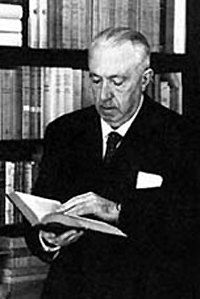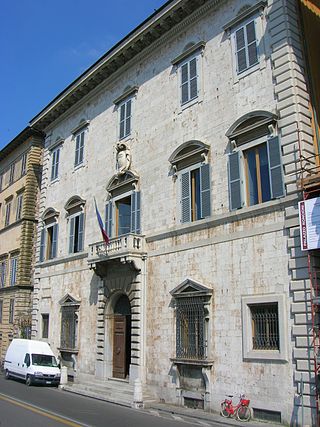
The Palazzo Lanfranchi is a palace located on Lungarno Galileo Galilei #8, in the city of Pisa, region of Tuscany, Italy.

The Palazzo Lanfranchi is a palace located on Lungarno Galileo Galilei #8, in the city of Pisa, region of Tuscany, Italy.
The aristocratic Lanfranchi family included diplomats serving the Medici Dukes of Tuscany; for example, in the 1530s, Albizzi Lanfranchi had been a diplomat for Cosimo I de' Medici. [1] The family had also owned a palace across the Arno, the Palazzo Lanfranchi-Toscanelli. This palace was reconstructed from 1539 to 1555, uniting a series of 13th and 14th-century houses with towers into a single palace. The palace has undergone many renovations, and has housed the Museo della Grafica since 2007. [2]
The Museum houses the collection of the Gabinetto Disegni e Stampe dell’Università di Pisa; initially curated in 1957 by Carlo Ludovico Ragghianti. Among the collection of prints and engravings included are those of Sebastiano Timpanaro senior, which has many acqueforti by Giovanni Fattori, and 19th and 20th-century works by Renato Birolli, Corrado Cagli, Massimo Campigli, Domenico Cantatore, Felice Carena, Carlo Carrà, Pietro Consagra, Primo Conti, Giorgio de Chirico, Pericle Fazzini, Lucio Fontana, Renato Guttuso, Carlo Levi, Mino Maccari, Mario Mafai, Giacomo Manzù, Marino Marini, Ottone Rosai, Toti Scialoja, Ardengo Soffici, Arturo Tosi, Alberto Viani, Lorenzo Viani, Giuseppe Viviani, Tono Zancanaro, Giorgio Morandi and Luigi Bartolini.
The collection also acquired 20th-century works by Giuseppe Capogrossi, Fabrizio Clerici, Emilio Greco, Ennio Morlotti, Bruno Munari, Achille Perilli, Arnaldo and Giò Pomodoro, Picasso, Aligi Sassu, Vittorio Tavernari, Ernesto Treccani, Emilio Vedova, Alberto Ziveri, and Mario Chiattone.
The museum also includes a collection donated by the Argan family, which has works by Carla Accardi, Luigi Boille, Giuseppe Capogrossi, Primo Conti, Antonio Corpora, Umberto Mastroianni, Luciano Minguzzi, Bruno Munari, Concetto Pozzati, Mauro Reggiani, Guido Strazza, Giuseppe Uncini, and Emilio Vedova. [3]

Pisa is a city and comune in Tuscany, central Italy, straddling the Arno just before it empties into the Ligurian Sea. It is the capital city of the Province of Pisa. Although Pisa is known worldwide for its leaning tower, the city contains more than twenty other historic churches, several medieval palaces, and bridges across the Arno. Much of the city's architecture was financed from its history as one of the Italian maritime republics.

Livorno is a port city on the Ligurian Sea on the western coast of Tuscany, Italy. It is the capital of the Province of Livorno, having a population of 158,493 residents in December 2017. It is traditionally known in English as Leghorn.

Carlo Emilio Gadda was an Italian writer and poet. He belongs to the tradition of the language innovators, writers that played with the somewhat stiff standard pre-war Italian language, and added elements of dialects, technical jargon and wordplay.

Grosseto is a city and comune in the central Italian region of Tuscany, the capital of the Province of Grosseto. The city lies 14 kilometres from the Tyrrhenian Sea, in the Maremma, at the centre of an alluvial plain on the Ombrone river.

Empoli is a town and comune in the Metropolitan City of Florence, Tuscany, Italy, about 30 km southwest of Florence, to the south of the Arno in a plain formed by the river. The plain has been usable for agriculture since Roman times. The commune's territory becomes hilly as it departs from the river. Empoli is on the main railway line from Florence to Pisa, and is the point of divergence of a line to Siena. Empoli has an enduring tradition as an agricultural centre. It has given its name to a local variety of artichoke.

The Ca' Pesaro is a Baroque marble palace turned art museum, facing the Grand Canal of Venice, Italy. Today it is one of the 11 museums run by the Fondazione Musei Civici di Venezia system.

The Palazzo Buonaccorsi is an 18th-century aristocratic palace, now the civic museum of the town, located on Via Don Minzoni 24 in the historic center of Macerata, region of Marche, Italy.
The Verzocchi collection or the Galleria Verzocchi - work in contemporary painting is a collection of over seventy 20th-century Italian paintings formed by the entrepreneur Giuseppe Verzocchi from 1949 to 1950. It contains only paintings of 90 by 70 cm and only on the themes of work and self-portraiture. Each painting is marked "V & D", the Verzocchi brand. It now forms part of the Pinacoteca civica di Forlì.
Armando Pizzinato was an Italian painter.
Fronte Nuovo delle Arti was an Italian artistic movement active in Venice, Rome and Milan in the years following WWII. It is considered to be part of the post-cubism movement.

The art collections of Fondazione Cariplo are a gallery of artworks with a significant historical and artistic value owned by Fondazione Cariplo in Italy. It consists of 767 paintings, 116 sculptures, 51 objects and furnishings dating from the first century AD to the second half of the twentieth.

The Palazzo Lanfranchi-Toscanelli, presently the local State Archives, is a Renaissance-style palace located on Lungarno Mediceo #30, in the city of Pisa, region of Tuscany, Italy. Since 1913 the building has housed the Archivio di Stato di Pisa.
Annibale Gatti was an Italian painter, known for history painting and fresco decoration in Tuscany.

The Palazzo degli Anziani also known as the Palazzo del Comune, della Comunitá or del Giano is a Gothic-style stone palace located in the ancient historic center of Pistoia, Tuscany, Italy. The palace served as city hall for centuries; it still belongs to the comune and now mainly houses the Museo Civico d'Arte Antica.
Lea Vergine, born Lea Buoncristiano, was an Italian art critic, essayist and curator.